Billie Holiday
The Lady of the Day
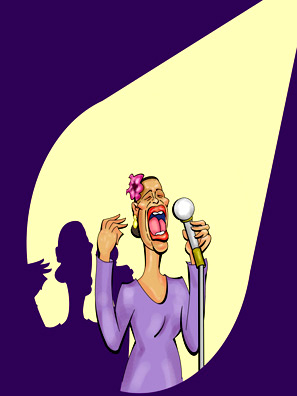
Billie Holiday
(Click to Zoom In and Out.)
A perusal through contemporary newspaper stories about Billie Holiday tells us two things.
First, in the 1940's Billie was one of the most acclaimed singers in America. She performed with the top musicians of the time: Benny Goodman, Artie Shaw, Paul Whiteman, and Duke Ellington. She sang at Carnegie Hall and toured the United States and Europe.
Next, even the best researched books about Billie's life vary in the telling. It's even hard to find out what her name was, for crying out loud!
Most biographies say Billie's real name was Eleanora Fagan. Thorough searching, though, indicates she was born as Elinore Harris on April 7, 1915, in Philadelphia. Confusion arises because Billie preferred the name Eleanora and her mom, Sarah (called Sadie), used her maternal grandmother's surname, Fagan.
You have to take some of the stories of Billie's autobiography Lady Sings the Blues with a grain or two. For instance, Billie said her mom and dad were sixteen and eighteen respectively when they got married. She, Billie (wink, wink), was three.
The actual documentation, though, shows that Clarence Holliday (he dropped the second "l" when he joined the army) was seventeen when Billie was born and he was the younger spouse. Some of the age discrepancies arise because when he joined up, Clarence said he was three years older than he was.
Clarence played guitar and he eventually became good enough to land work with Fletcher Henderson and other bands of that calibre. He died in 19371.
Footnote
The usual story is that Clarence has been wounded by poison gas during the First World War and ultimately succumbed to the injuries. Although one author found no specific record of such an injury, Clarence did die in a Veteran's Administration hospital in Texas.
In any case, Billie's telling was a pardonable cover for the fact her parents were never married at all. In fact, they didn't even live together and Clarence rarely acknowledged any relationship. He sometimes went under a different name to hide his whereabouts.
Sadie definitely had bad luck with men. She later married a longshoreman named Philip Gough and she and Billie began to use that name. But Philip soon walked out leaving Sadie and Billie alone. Another marriage didn't last either and again Sadie and Billie were on their own.
In 1925 (or 1928 depending on who you believe), Billie and her mom moved to Baltimore. As before Sadie worked at a number of menial jobs but somehow managed to scrape by. Then when Billie was fifteen they pulled up stakes again and moved to Harlem.
Billie didn't have much interest in school and she was reported absent so often that she was hauled into juvenile court. The stern lady judge remanded the errant waif to the House of Good Shepherd for Colored Girls, a Catholic school intended to bring the wayward young ladies back into the fold of righteousness. Billie was there for 10 months before she returned home.
In Billie's own telling she refused to take on degrading jobs like scrubbing floors. On the other hand she said she had no hesitation in turning to - ah - "other employment". And the police records do show that Billie - or rather Eleanora Fagan - was once arrested at an enterprise specializing in gentlemen's comfort.
The oft-told tale is that Billie auditioned as a dancer in a club but she wasn't at the sufficient calibre. But when the piano player asked if she could sing, she gave an amazing rendering of "Body and Soul". So they hired her immediately at a couple of bucks a night.
This, too, is a pardonable simplification. No, Billie didn't just show up at a nightclub and get a job singing to the customers. She got experience singing in church functions and she appeared at amateur nights at the local theaters.
In a day before muzak wafted through the elevators, good music had to be live music. So the smaller nightclubs offered an entryway for new talent. A prospective singer would show up at a club and ask to sing. She might get no pay but the customers could pass the hat. Then after a few songs she'd head off to another club. Eventually from the experience (and the contacts made), the singer might turn full time - if she was good enough.
Well, Billie was good enough and her first real professional job was singing at the Grey Dawn nightclub in Queens. This was in 1930 and Billie was only fifteen. When she moved to Harlem's Nest Club in 1933, she began calling herself Billie Halladay. Why the variant spelling no one knows, although some sources do mention Clarence's real name was Halliday. But in either case, both Clarence and Billie switched to Holiday.
The pace for the fledgling singers was grueling. They'd start work at two o'clock in the morning and sing past daylight. Then they'd find someplace to hang out to relax and unwind. They wouldn't get any shuteye until 4 or 5 in the afternoon and then they'd have to wake up in time to get to the club and start the cycle again
One scholar reported the pay for the girls was $100 a week. That's clearly an erratum. After all $100 a week was extremely good pay during the Great Depression - about ten times that of the average worker. Physicians averaged about $60 a week - which is the same pay that bluegrass banjo virtuoso Earl Scruggs was making in 1946 playing for Bill Monroe. And in 1970, a young assistant editor of a small town newspaper was taking in $88 a week.
Instead, the $100 a week is roughly what Billie got when she signed a recording contract with Vocalion Records. Vocalion didn't pay her royalties but the executives did agree to a $5000 yearly contract - a tad less than the $100 per week cited2. At other times she was paid $100 for cutting four sides. The sidemen for the records usually received about $5 for half a shellac.
Footnote
It's one thing to have a contract and it was another thing to get paid. Sometimes the early record companies were less than prompt in compensating their artists. The owner of Folkways Records, Moses Asch, was notoriously tight-fisted. Dave Van Ronk, one of Moe's recording artists in the 1960's, would sometimes put on a ragged suit and wait until Moe's office was full. Then he'd stagger in and shout "Moe! You're not paying me!" Moe would go along and say "Why, Dave! I'm glad to see you! I was just about to write you a check!" There was even one one pop singer who had signed with a major record producer who was earning money shoveling coal while one of his group's songs was #1 on the charts.
But we must admit that profit margins were sometimes slim. In the 1930's a single record might sell for as as low as 35¢. One record producer said it was hard to make money at 35¢ a platter.
When we said the singers spent some times relaxing we don't mean they sat around playing gin rummy or mah jong. It was common for them to quaff generous portions of beverages which had just become legal after the repeal of the 18th Amendment. There were also, well, other substances that the performers consumed.
One stereotype of the jazz musician was that as the big time boozer and junkie. Although it's true that the percentage of jazz musicians who were active users isn't known and what is now called substance abuse wasn't just limited to a few bad apples. One band leader complained it was hard to staff a trio without at least one drug addict.
Billie fell into the trap early. She started on alcohol and "reefers" as a teenager, and soon she was turning to harder drugs.
And one of the drugs was the Big H. That's snow, snowball, the dragon, junk, white, Mexican mud, Number 3, dragon, black pearl, Mexican brown, skunk, China white, brown rhine, brown, brown tape, brown crystal, boy, white boy, smack, horse, Mexican horse, He, dope, scat, black eagle, white nurse, black stuff, white lady, white girl, brown sugar, Number 8, white stuff, sack, dope, skag, tar, black tar, white horse, mud, black, Number 4, H, and [(4R,4aR,7S,7aR,12bS)-9-acetyloxy-3-methyl-2,4,4a,7,7a,13-hexahydro-1H-4,12-methanobenzofuro[3,2-e]isoquinolin-7-yl] acetate. In other words, heroin.
As a performer Billie was no demur coquette. In fact, club owners found she could be fractious, and some even thought of her as arrogant. She also had quite the potty mouth and would toss out the casual "MF's" with élan. In 1930 she was arrested for being drunk and disorderly.
Part of the difficulty - if you want to call it that - is that Billie expected to be treated with respect. One time she didn't think a nightclub audience was paying sufficient attention. Turning her back to the crowd she gave them a time honored gesture. As for what that gesture was, we'll only say if she had been singing "How High the Moon", it would have been appropriate.
Living in New York, Billie would occasionally see her dad. Clarence was now a full time musician and playing with big name leaders. Billie would go to where he was playing and call him "Daddy". Although this embarrassed Clarence, some who knew both said that Billie and her dad actually got along OK.
Billie's big break came in 1933 when she was singing at the Covan's Club in Harlem. John Hammond, a young man of affluence (his great-great-granddad was Cornelius Vanderbilt) was just beginning to move into the record producing business. John showed up at Covan's thinking he would see Monette Moore, a well-known jazz singer who had been appearing on Broadway. But he was flabbergasted to find a 17 year old kid singing better than Monette. He returned later with some of his musically knowledgeable friends. They all agreed the girl was fantastic.
Just ask ...
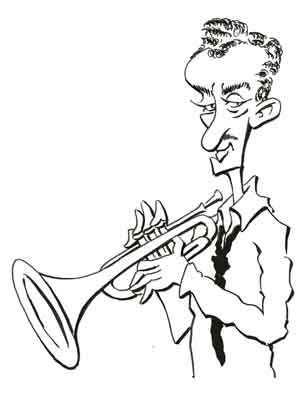
... Harry ...
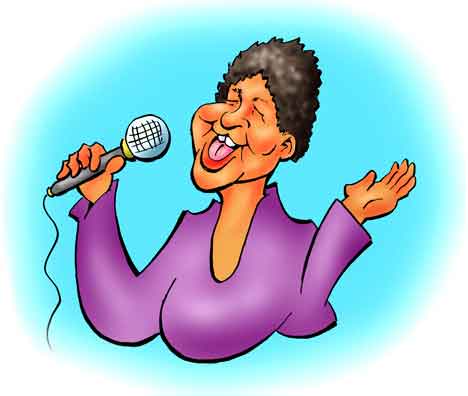
... Aretha ...
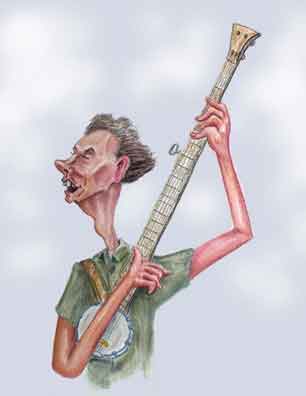
... Pete ...
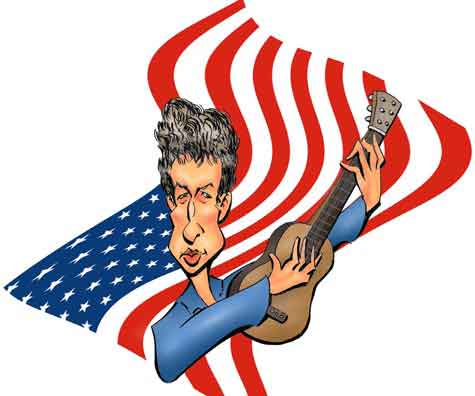
... and - ah - "Robert".
John was the right man to impress, not just for his business acumen but for his longevity. For decades if John liked your stuff, he could open the doors to stardom. Just ask musicians like Count Basie, Harry James, Aretha Franklin, Pete Seeger, and even Bruce Springsteen, for heaven's sake! Not to mention a future Nobel Prize winner named Robert Zimmerman.
Those who have heard the praise for Billie's singing might be surprised when they hear her for the first time. She did not sing in sweetsy dulcet and sugary tones. Instead her voice was pitched to a low contralto that sometimes had a rough edge, even a rasp, to it. For some this was a detriment and John said he got more static from the record executives for her unique timbre than he did from the extremely non-conventional nasality of Bob Dylan. But Billie's singing stood out and her fans loved it.
After hearing Billie sing, John told one of his musical associates, clarinetist Benny Goodman, that he should work with Billie. Benny was not yet a big band leader but he was putting out successful records. In 1934, he played with Billie on "Riffin' the Scotch".
The same year Billie appeared for the first time at Harlem's Apollo Theater. The next year she returned for a performance with Duke Ellington in his Symphony in Black: A Rhapsody of Negro Life. Duke Ellington was even then and later years an iconic figure. So appearing with Duke was a plus even though Billie was only one of the chorus and wasn't given a credit.
But by 1935 her solo career began to take off, and when she was in New York, Billie began packing in the hot spots. She appeared at Kelly's Stable, the Onyx Club, and the Yacht Club. She signed contracts with Decca and Columbia - top labels - and in 1937 Billie toured with Count Basie. The next year she signed on with Artie Shaw. Again a big name.
Touring, even with big bands, wasn't always a great way to make a living. Not only was it a never ending grind of moving from one town to another, but as a black woman Billie found herself having to stay in separate and most unequal accommodations. At some restaurants, she had to eat in the kitchen and some places wouldn't even serve her there. Although she said most of her traveling companions were nice, she got tired "of making a Federal case over breakfast, lunch and dinner. You had to smile to keep from throwing up. As they say, 'There's no business like show business.'"

Duke Ellington
Iconic
Probably Billie's most famous song is "Strange Fruit" which she first recorded in 1939. The song was about the lynchings in the American South and is called the first protest song. Franklin Roosevelt had been trying for years to get legislation passed to make these extra-judicial executions a federal crime but had no luck. To date, no federal anti-lynching law has passed both houses and signed into law.
A song almost as famous but not with such a clear cut message was "Gloomy Sunday". The BBC banned the song - not just Billie's version - because the BBC Powers That Be thought that playing it would cause morale problems during World War II. Of course the BBC has been famous for rabid scotching of songs lest they cause offense. They even banned "Deep in the Heart of Texas" sung by Bing Crosby!
In 1945 Billie began a cross country tour and had been named as the #1 singer in polls taken by Esquire magazine. But the 1940's also brought in ominous signs as her use and abuse of drugs and alcohol continued.
In 1947, Billie was arrested and convicted for possession of narcotics. She was sentenced to a year and a day - the crime was a felony - and she was sent to the women's minimum security prison at Alderson, West Virginia. Alderson was the first federal prison exclusively to house women and was attempting to focus on rehabilitation. There were no armed guards and the women lived in dormitory-like buildings. Billie was released on May 18, 1948, after nine months.
Unfortunately, Billie's time in prison did not "straighten her out" to use a phrase of the follicularly challenged in a quaint state in the American Southwest. Worse, New York City had a rule that anyone convicted of a crime couldn't get a permit to perform in nightclubs (or anywhere that served alcohol). The irony was that although now Billie couldn't sing in nightclubs, she could sing in theaters. Less than two weeks after she left prison, she appeared before a sold out crowd in Carnegie Hall. Billie played three more times in this most venerable of concert halls, once in 1952 and twice in 1956.
Naturally with the new technology arising in the late 1940's, Billie appeared on the then infant medium of television. She sang on the early series, We, the People in 1948, and on the Art Ford Show in 1949.
Then in 1954 Billie was a guest on, yes, The Tonight Show hosted by Steve Allen. Then called simply Tonight!, the show's band was led by Skitch Henderson who stayed on as Johnny Carson's bandleader before Doc Severinsen came in. The announcer was none other than Gene Rayburn, later famous for his rather wild and crazy hosting of The Match Game.
Billie enjoyed touring Europe and loved England. For one thing there was no legal discrimination and she could stay in any hotel and go into any restaurant. And her last appearance on television was in March, 1959, on the English variety show Chelsea at Nine.Like her mother, Billie had difficulty in her dealings with men and how often she was married isn't clear. Some articles mention four marriages, but there are only two names anyone cites. One is trombonist James "Jimmy" Monroe who Billie married in 1941. That marriage didn't last. Then in 1957 she married Louis McKay, a booking agent. Other designations of Louis's position in the world are rather severe.
On the other hand, Billie had long-time men friends like saxophonist Lester Young. She dubbed him "Prez" and he returned the compliment by bestowing her the title "Lady Day".
Lester had known Billie since her early days in New York. He had even lived for a time with Billie and her mother, saying he liked Sadie's good home cooking. Billie and Lester always maintained that they were just good friends, but naturally people wonder.
Despite her fame, Billie did not make a lot of money. Part of the problem was simply that jazz records never really have sold that well. And because she was denied a cabaret card, the source of her most steady income had dried up. Then of course there was her drug habit which consumed more and more of her dwindling supplies of cash.
Old habits are hard to break and bad habits are the hardest of all. Early in 1959 Billie learned she had cirrhosis of the liver. The doctors told her she needed to quit drinking but old habits really are hard to break.
On March 15, her good friend Lester Young died, age 49. Then at end of the month Billie fainted in her apartment. She was rushed to a hospital.
Unfortunately, it was a private institution that didn't want to bother with patients who didn't have the "ready". So Billie lay on a gurney in a hallway for an hour before the doctors told attendants to send her to Harlem's Metropolitan Hospital.
Billie was admitted as Eleanora McKay and no one knew who she was. But a nurse saw some white powder on her face and called the cops.
The Feds came in and arrested her for possession of narcotics. Since she wasn't in a condition for them to haul her into court, they thought about bringing a judge to her. But before it came to that, on July 17, 1959, Billie died.
References and Further Reading
Billie Holiday, Earle Rice, Lane Publishers, 2013.
Billie Holiday: A Biography, Meg Greene, Greenwood Publishing, 2006.,
Wishing on the Moon: The Life and Times of Billie Holiday, Donald Clark, Viking, 1994
"Billie Holiday, American Jazz Singer", Encyclopedia Britannica.
"Billie Holiday", Biography, January 1, 2014.
"Billie Holiday's Story Was Even More Complicated Than You Think", Lily Rothman, Time Magazine, April 7, 2015.
Billie Holiday: The Wild Lady of Jazz Who Adored England", Martin Chilton, The Independent, July 17, 2019.
"The Facts Behind the Legend of Jazz Great Billie Holiday", Bob Blumenthal, Chicago Tribune, October 30, 1994.
"Billie Holiday: After a Hard Life and a Lonely Death, the Legend Lives On", Michael Ross Dominicis, The Collegian, April 10, 1985.
"Billie Holiday: The Musician and the Myth Review – A Celebration of a True Original", Neil Spencer, The Guardian, May 23, 2015.
"Billie Holiday's Bio, 'Lady Sings the Blues' May Be Full of Lies, But It Gets at Jazz Great's Core", Jesse Hamlin, San Francisco Chronicle, September 18, 2006.
"Clarence Holiday", Scott Yanow, AllMusic.
"Billie Holiday's Husband, Louis McKay, Dies at 72", Jet, April 2, 1981.
"The Art of Billie Holiday's Life", Richard Brody, The New Yorker, April 3, 2015.
"Why It Took a Century to Pass an Anti-lynching Law", Louis P. Masur, The Washington Post, December 28, 2018.
"Banned: The Songs Deemed 'Too Dangerous' for the BBC", Stephen Dowling, June 20, 2019.
"How High the Moon: Jazz and Drugs", Charles Winick, The Antioch Review, Vol. 21, No. 1, pp. 53-68, 1961.
"The Depression Facts", The Great Depression, October 28, 2012.
"Drug Street Names", Addiction Center.
"Billie Holiday", Internet Movie Data Base.
Chronicling America, Library of Congress.
"Billie Holiday, Blues Singer, Will Sing At a Dance of the Evans", [Washington] Evening Star, p. 45, November 18, 1949
."Billie Holiday, Singer, Indicted on Opium Count", [Washington] Evening Star, p. 7, February 11, 1949
."Prez & Lady Day: The Story of Billie Holiday and Lester Young", The Jim Cullum Riverwalk Jazz Collection.
"Alderson Women's Prison in West Virginia Home to Both Famous and Infamous", Theresa Vargas, The Columbus [Ohio] Dispatch, June 18, 2017.
"Cabaret Employee's Card In New York", The [Dayton] Ohio Daily-Express, p. 1, March 30, 1949.
"Billie Holiday Slated for Cross Country Tour", The Detroit Tribune, September 22, 1945, p. 13.